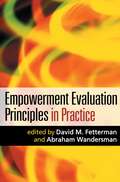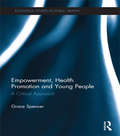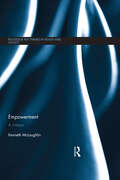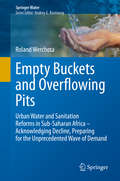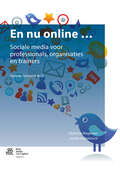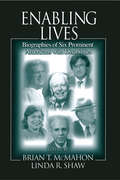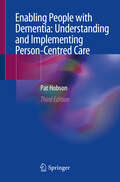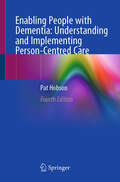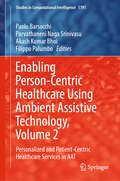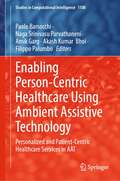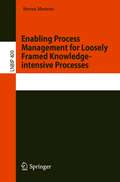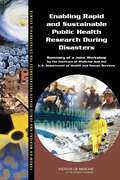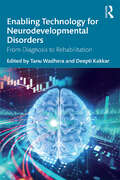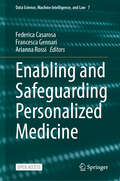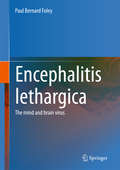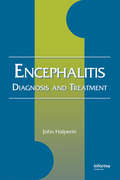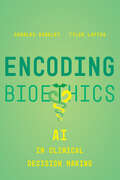- Table View
- List View
Empowerment Evaluation Principles in Practice
by David FettermanWhat principles should guide an empowerment evaluation? And how can these principles actually be put into practice? One of the primary tasks in an empowerment evaluation (EE) is to increase the capacity of program stakeholders to plan, implement, and evaluate their own programs. This book presents the most current formulation of the 10 principles of EE and provides professionals and students with the tools to put these principles into practice. Through case studies of diverse evaluation projects--including community health foundation initiatives, school district programs, and a $15 million corporate program aimed at bridging the digital divide--the founder and leading proponents of EE clarify key concepts and discuss important lessons learned. Coverage includes how to balance program improvement efforts with accountability requirements; how EE can be used to guide standards-based work; how to use EE in a learning organization; the differences among empowerment, collaborative, and participatory evaluation; and much more.
Empowerment, Health Promotion and Young People: A Critical Approach
by Grace SpencerGlobally, young people’s health is an increasing priority area for health practitioners, policy-makers and researchers, and concepts of empowerment feature strongly in international public health discourses on young people’s health. Yet the concept of empowerment remains under-theorized, and its relationship to young people’s health is not well understood. This innovative volume critically examines the concept of empowerment and its relationship to young people’s health. Empowerment, Health Promotion and Young People is set out in two main parts. Part one examines differing conceptions of power and empowerment and how these concepts have been variously defined and used in relation to young people’s health and health promotion. Part two offers a new theoretical framework for understanding empowerment as it relates to young people’s health. Drawing together key works in the field and findings from an empirical enquiry on young people’s health, this framework looks at health as it is defined by young people themselves, and offers new directions for empowerment, and critical insights into the field of young people’s health and health promotion. Critically engaging with the concept of power and opening up the debate about the relevance and effectiveness of using contemporary understandings of empowerment to promote health, this book is suitable for researchers and students of health, sociology, education and youth studies interested in young people’s health and health promotion.
Empowerment: A Critique (Routledge Key Themes in Health and Society)
by Kenneth McLaughlin‘Empowerment’ is a term in widespread use today and one that is often considered to be a self-evident good. Here, McLaughlin explores its emergence in the 1960s through to its rise in the 1990s and ubiquity in present day discourse and interrogates its social status, paying particular attention to social policy, social work and health and social care discourse. He argues that a focus on empowerment has superseded the notion of political subjects exercising power autonomously. This innovative volume: - Discusses the relationship between concepts of empowerment and power, as they have been understood historically. - Analyses changes in the conception and meaning of empowerment in relation to the shifting social and political landscape. - Acknowledges the positive impact empowerment strategies have had on those who have campaigned to be empowered and also on those who have saw their role as being to help empower others. - Highlights ways in which talk about empowerment can actually work in such a way as to further disempower those already marginalised. Critically examining how ‘empowerment’ has become embedded in contemporary social and political life, this work offers a discussion of the term’s multiple meanings, what it actually entails, and how it constructs and positions those being empowered and those empowering.
Empty Buckets and Overflowing Pits: Urban Water and Sanitation Reforms in Sub-Saharan Africa – Acknowledging Decline, Preparing for the Unprecedented Wave of Demand (Springer Water)
by Roland WerchotaThis book provides a multi-level and multi-dimensional insight into urban water and sanitation development by analyzing sector reforms in Africa. With the recent events in mind - water shortages in Cape Town, widespread cholera in Haiti, mass-migration from low-income countries, etc. – it elaborates a pressing topic which is directly linked to the precarious living conditions of the urban poor in the developing countries. It is urgent to acknowledge the proposed findings and recommendations of the book which will help to improve the situation of potential refugees in their home countries with a realistic vision for the development of the most basic of all life supporting services.So many efforts to reverse the negative trend in water and sanitation development have failed or targets have been repeatedly missed by far without notable consequences for decision makers on different levels and institutions. It has unnecessarily consumed many young lives, contributed to keep billions in poverty until today and fostered discrimination of women. The knowledge gap and the confusion in the sector lined out in the book becomes evident when a national leader in a low-income country declares a state of emergency in urban water and sanitation while at the same time global monitoring publishes an access figure for urban water of over 90% for the same country. It is time to change this with an effective sector development concept for our partner countries and a more realistic discourse on global level.The book argues for a sweeping rethinking and combines extended local knowledge, lessons learned from history in advanced countries and thorough research on reforms in Francophone and Anglophone developing countries. This was possible because the writer was working in Sub-Saharan partner countries for almost 30 years as an integrated long term advisor in different sector institutions (ministry, regulator, financing basket and different sizes of utilities) and had the opportunity to cooperate closely with the main development partners.The reader has the opportunity to obtain a comprehensive understanding of how the sector works and sector institutions in low-income countries function and can discover the reasons behind success and failures of reforms. The book also covers issues which have a significant influence on urban water and sanitation development but are hardly the subject of discussions. It helps to make the shortcomings of the water and sanitation discourse more apparent and assist institutions to move beyond their present perceptions and agendas. All of this makes the book different from other literature about urban water and sanitation in the developing world.
Empty Hands, A Memoir
by Desmond Tutu Kittisaro And Thanissara Sister Abega NtlekoEmpty Hands is the inspiring memoir of Zulu nurse and healthcare activist Sister Abegail Ntleko. Growing up poor in a rural village with a father who didn't believe in educating girls, against seemingly insurmountable odds Sister Abegail earned her nursing degree and began work as a community nurse and educator, dedicating her life to those in need. "Her story tells us," says Desmond Tutu, who wrote the foreword to the book, "what a single person can accomplish when heart and mind work together in the service of others."Overcoming poverty and racism within the apartheid South African system, she adopted her first child at a time when it was unheard of to do so. And then she did it again and again. In forty years she has taken in and cared for hundreds of children who had nothing, saving babies--many of them orphans whose parents died of AIDS--from hospitals that were ready to give up on them and let them die. Empty Hands describes the harshness of Ntleko's circumstances with wit and wisdom in direct, beautifully understated prose and will appeal not only to activists and aid workers, but to anyone who believes in the power of the human spirit to rise above suffering and find peace, joy, and purpose."Ntleko's story, which she tells in simple language, is inspiring and moving. She neither dwells in nor dramatizes the hardships she has faced, preferring instead to focus on 'fill[ing] her hands with love and then spend[ing] all that love until [her] hands are empty again.' A brief, genuine, heartfelt memoir of an awe-inspiring life."--Kirkus ReviewsFrom the Trade Paperback edition.
Empty Harvest: Understanding the Link Between Our Food, Our Immunity, and Our Planet
by Bernard Jensen Mark AndersonEmpty Harvest puts together a sober picture of how interconnected man is to the earth, and how this connection is being destroyed. But the book also offers a wide range of practical, long-term solutions that are still available to us.
En Route: A Paramedic's Stories of Life, Death, and Everything in Between
by Steven Kelly GraysonStephen "Kelly" Grayson has seen the best of us at our worst. When hearts stop working, when blood alcohol levels exceed limits we shouldn't contemplate, when bodies are extricated from car wrecks, he's been there to pick up the pieces, save our lives, and watch us slip away. His touching stories of life and death and the hilarious ones of times in between are here to give us an insight of what happens after we call 911, the ambulance doors close, or even what happens inside the ER when the nurse shows the family to the waiting room.
En defensa de la marihuana
by Mauricio PurtoMauricio Purto aporta a la discusión sobre la marihuana tratando de derribar los mitos que la rodean Fue el primer doctor que recetó cannabis como droga medicinal en Chile. Pese a desalentar su consumo entre niños y jóvenes. Mauricio Purto realiza en este libro una encendida defensa de la marihuana desde una perspectiva científica y personal. El destacado montañista, líder de la expedición chilena que subió el Everest, echa mano de su larga y profunda experiencia, de antiquísimos textos de la medicina ayurvédica y las más innovadoras investigaciones de la ciencia actual,de estudios que se remontan a principios del siglo xx, sin dejar de lado su propio trayecto como fumador de yerba, para entregarnos un texto provocador a la vez que revelador sobre los beneficios de la marihuana.
En nu online ...: Sociale media voor professionals, organisaties en trainers
by Sibrenne Wagenaar Joitske HulseboschEn nu online ... Sociale media voor professionals, organisties en facilitatoren laat zien hoe sociale media werken. Dit wordt uitgebreid geïllustreerd aan de hand van praktijkvoorbeelden en - verhalen
Enabling America: Assessing the Role of Rehabilitation Science and Engineering
by Andrew M. Pope Edward N. BrandtThe most recent high-profile advocate for Americans with disabilities, actor Christopher Reeve, has highlighted for the public the economic and social costs of disability and the importance of rehabilitation. Enabling America is a major analysis of the field of rehabilitation science and engineering. The book explains how to achieve recognition for this evolving field of study, how to set priorities, and how to improve the organization and administration of the numerous federal research programs in this area.The committee introduces the "enabling-disability process" model, which enhances the concepts of disability and rehabilitation, and reviews what is known and what research priorities are emerging in the areas of: Pathology and impairment, including differences between children and adults. Functional limitations--in a person's ability to eat or walk, for example. Disability as the interaction between a person's pathologies, impairments, and functional limitations and the surrounding physical and social environments. This landmark volume will be of special interest to anyone involved in rehabilitation science and engineering: federal policymakers, rehabilitation practitioners and administrators, researchers, and advocates for persons with disabilities.
Enabling Lives
by Linda R. Shaw Brian T. McMahonEnabling Lives provides a look at the disability civil rights movement through an intimate portrayal of the lives of several of its key leaders. Each of the chapters of this book is a separate authorized biography of such prominent figures as Frank Bowe, Tony Coelho, Justin Dart, Judy Heumann, Evan Kemp, and Harold Russell. Enabling Lives provides not only an accurate historical record of key moments in the development of civil rights for individuals with disabilities, but also invites the reader to become acquainted with the individuals who helped to shape the movement and to view history in the making through the eyes of those who were helping to create it.Each of the book's subjects has provided countless hours of interviews, recollections and "war stories" into the making of this important work, helping to create a legacy that hopefully will be carried on by the current and future leaders of the movement.
Enabling People with Dementia: Understanding And Implementing Person-centred Care
by Pat HobsonThis new updated edition challenges the perceptions, beliefs and attitudes of professionals working in dementia care settings by drawing on the theory of person-centred care. It demonstrates the importance of this theory for interacting with and caring for people with dementia. It also provides an overview of the theory in relation to two other well-known theories on dementia, and stresses the need to consider the world from the perspective of people with dementia. Moreover, the book examines the importance of dementia care environments, positive interactions, meaningful activities and the concept of personhood, which are all essential to improving the health and wellbeing of people living with dementia. In closing, it underscores the need to remember that the focus of care should be on maximizing the person’s abilities, enabling them, and promoting person-centred care. Given its content and style, the book offers a resource that can be read and understood by health and social care professionals alike, as well as anyone else caring for someone with dementia, including family members and carers.
Enabling People with Dementia: Understanding and Implementing Person-Centred Care
by Pat HobsonThis new updated edition draws on the theory of person-centred care to challenge the perceptions, beliefs, and attitudes of professionals working in dementia care settings. It shows the importance of interacting with and caring for people with dementia and stresses the need to consider the world from the perspective of people with dementia. New chapters in this edition develop on the management of end-stage dementia and end of life by underlining the importance of advanced care decisions and planning, or of psychosocial and spiritual support. New chapters will also help manage distress and changes in behaviour as well as common symptoms associated with end of life in dementia.In addition, this book studies dementia care environments, positive interactions, meaningful activities and the concept of personhood, to show their significance in improving the health and well-being of people living with dementia. Finally, this book gives a voice to the carers by sharing their experiences of dementia, and underscores the need to remember that the focus of care should be on maximizing the person’s abilities, enabling them, and promoting person-centred care.
Enabling Person-Centric Healthcare Using Ambient Assistive Technology, Volume 2: Personalized and Patient-Centric Healthcare Services in AAT (Studies in Computational Intelligence #1191)
by Akash Kumar Bhoi Paolo Barsocchi Filippo Palumbo Parvathaneni Naga SrinivasuThis book focuses more on the transformative impact of person-centric health care, where it explores cutting-edge advancements in integrating artificial intelligence and machine learning to deliver personalized and efficient care. Key topics include the application of predictive models for critical health conditions such as brain stroke, lung cancer, diabetes, and Alzheimer's, as well as the integration of secure frameworks to protect sensitive patient data. The book also covers advanced techniques for recognizing human activities in ambient environments, optimizing patient data clustering, and evaluating deep learning methods for unique use cases like yoga pose classification and resource optimization in smart healthcare. Designed for healthcare professionals, researchers, data scientists, and technologists, this book presents a harmonious blend of technical insights and practical applications, emphasizing person-centric approaches. By focusing on multi-disease prediction, assistive technologies, and enhanced emergency management, this book serves as a vital resource for innovating healthcare delivery in smart environments.
Enabling Person-Centric Healthcare Using Ambient Assistive Technology: Personalized and Patient-Centric Healthcare Services in AAT (Studies in Computational Intelligence #1108)
by Akash Kumar Bhoi Amik Garg Paolo Barsocchi Naga Srinivasu Parvathaneni Filippo PalumboThis book experiences the future of patient-centered healthcare and dives into the latest advancements and transformative technologies that are revolutionizing the well-being of individuals around the globe. The readers can join authors on an engaging journey as the authors explore the captivating realm of ambient assisted living and unlock its immense potential for improving healthcare outcomes. This book goes beyond mere exploration; it invites readers to embark on a voyage of discovery as authors unveil the outcomes of groundbreaking research ideas. With a diverse range of applications, from deep learning in healthcare to cutting-edge models, the authors offer a comprehensive view of the opportunities and challenges that lie ahead. Whether you're a healthcare professional, an academic seeking the latest insights, or a researcher delving into the realms of ambient assistive technology, biomedical engineering, or computational intelligence, this book is an invaluable resource. Additionally, postgraduate students pursuing data engineering systems find it to be an essential guide. Each chapter stands independently, providing a comprehensive overview of problem formulation and its tangible outcomes. The readers can immerse themselves in the world of patient-centered healthcare today and become part of the forefront of innovation.
Enabling Process Management for Loosely Framed Knowledge-intensive Processes (Lecture Notes in Business Information Processing #409)
by Steven MertensThis book is a revised version of the PhD dissertation written by the author at the Department of Business Informatics and Operations Management at Ghent University in Belgium.It addresses shortcomings in Business Process Management concerning loosely framed knowledge-intensive processes, which are characterized by their numerous valid process variants and their reliance on knowledge workers to apply their knowledge to decide on a suitable process variant that fits the context of a specific process execution. The goal was to lay the foundation for a process-aware business process management (IT-)system to support such processes. Several proof-of-concept implementations have been made for the core components and were evaluated in the domain of the healthcare. Starting from an artificial, but realistic, case about patients that arrive in the emergency room with suspected arm fractures and later progressing to a case study of the diagnosis and treatment of patients in the emergency department of a real hospital, using data from their patient files. In 2020, the PhD dissertation won the “CAiSE PhD award”, granted to outstanding PhD theses in the field of Information Systems Engineering.
Enabling Rapid and Sustainable Public Health Research During Disasters: Summary of a Joint Workshop by the Institute of Medicine and the U.S. Department of Health and Human Services
by Megan ReeveOver the past decade, preparedness and response capacities of government agencies, hospitals and clinics, public health agencies, and academic researchers in the United States and abroad have been challenged by a succession of public health emergencies, ranging from radiological threats to pandemics to earthquakes. Through After Action Reports, each of these emergencies has yielded important information and lessons learned that can inform future disaster response and recovery efforts. However, important information that needs to be collected during and immediately following these emergencies is often missed because of barriers and obstacles to gathering such data, such as varying institutional review board restrictions in different states, no sustainable funding network for this type of work, uncertainty on who should be involved in research response, and a lack of knowledge around how best to integrate research into response and recovery frameworks. Taking action to enable medical and public health research during disasters was the focus of a workshop held on June 12 and 13, 2014, coordinated and supported jointly by the Institute of Medicine Forum on Medical and Public Health Preparedness for Catastrophic Events, National Institute of Environmental Health Sciences, the National Library of Medicine, the U. S. Department of Health and Human Services' Office of the Assistant Secretary for Preparedness and Response, and the Centers for Disease Control and Prevention. Invited speakers and participants from federal, state, and local government, academia, and community and worker organizations came together to discuss how to integrate research into existing response structures; identify critical research needs and priorities; identify obstacles and barriers to research; discuss structures and strategies needed for deployment of a research study; share ideas, innovations, and technologies to support research; and explore data collection tools and data-sharing mechanisms for both rapid and longitudinal research. "Enabling Rapid and Sustainable Public Health Research During Disasters" summarizes the presentations and discussion of the workshop.
Enabling Technology for Neurodevelopmental Disorders: From Diagnosis to Rehabilitation
by Tanu WadheraThis cutting-edge volume explores how technological tools can be designed, engineered and implemented to assess and support individuals with neurodevelopmental disorders from diagnosis through to rehabilitation. Tanu Wadhera and Deepti Kakkar and their expert contributors focus on technological tools as equalizers in Neurodevelopmental disorders (NDDs) at every stage, the importance of demand-specific design, and how we can best engineer and deploy both invasive and non-invasive individual-centered approaches that support and connect individuals. Considering the perspectives of patients, clinicians and technologists, it explores key topics including design and evaluation of platforms for tech-tools, automated diagnosis, brain imaging techniques, tech-diagnostic frameworks with AI and machine learning, sensing technology, smart brain prosthetics, gamification, alternative communication devices, and education tools and interactive toys. Outlining future challenges for research, Enabling Technology for Neurodevelopmental Disorders is useful for scholars and professionals in psychology, technology, engineering and medicine concerned with design, development and evaluation of a range of assistive technological tools.
Enabling and Safeguarding Personalized Medicine (Data Science, Machine Intelligence, and Law #7)
by Arianna Rossi Federica Casarosa Francesca GennariThis open-access volume provides a comprehensive guide to the most pressing challenges arising from the technologies that enable personalized medicine. It brings together theoretical, empirical, and case study-based contributions that span across disciplinary boundaries to examine related problems and propose solutions critically. Personalized medicine is the next frontier in scientific, public health, and commercial advancements. By recognizing the uniqueness of each human body, data-driven treatments and digital, robotic devices are being increasingly developed to enable patients and medical personnel to benefit from highly accurate and personalized diagnoses and therapies. Healthcare customization is based on predictive, preventive, personalized, and participatory elements – each of which requires an interplay between healthcare systems, medical personnel, patients, as well as bioengineers, economists, regulators, lawyers, and business owners. If the goal of more proactive patient inclusion is to enhance the efficacy of personalized medical interventions, it is also paramount to evaluate whether the adoption of customized solutions is sustainable from both economic and organizational perspectives. Legal norms provide the framework in which the development of new medical devices, the sharing of data for the public good, and the provision of healthcare may occur. This area of research and practice is regulated by a complex mix of norms concerning personal and non-personal data, AI governance, cybersecurity, health law, and liability regimes. In ever-evolving domains where some regulations still need to be defined, approved, or implemented, researchers and practitioners need guidance to enable the safe-by-design development of medical technologies. The book is organized in three sections: I) &“Facilitating and Protecting Personalized Medicine,&” which revolves around the mechanisms that enable the sharing and reuse of health data within the Common European Data Spaces, seeks to address the cybersecurity challenges posed by medical technologies, and critically discusses the definition of scientific research in recent legislative efforts; II) &“Scoping Challenges Through the Players in the Personalized Medicine Ecosystem,&” which gathers varied interdisciplinary insights from scholars and practitioners in the fields of medicine, economics, engineering, education and compliance; and III) &“Challenges of Personalized Medicine for Liability,&” which focuses on the challenges that personalized data-driven medicine poses for traditional and novel liability regimes.
Encephalitis Lethargica
by Paul Bernard FoleyEncephalitis lethargica (‘sleeping sickness’) was a mysterious disorder that swept the world in the decade following the First World War, before disappearing without its cause having been identified. Around 85% of its victims, predominantly children, adolescents and younger adults, survived the acute disorder, but most developed severe neurological syndromes, particularly severe post-encephalitic parkinsonism and other severe motor abnormalities, that incapacitated them for the remainder of their lives. Despite its brief history, encephalitis lethargica played a major role in a variety medical discussions between the two World Wars, as this epitome of neuropsychiatric disease – attacking both motor and mental functions – appeared just as the separation of neurology and psychiatry had reached a critical point. Encephalitis lethargica sufferers presented an unprecedented combination of neurologic and psychiatric symptoms – including previously puzzling phenomena primarily associated with schizophrenia and hysteria, as well as behavioral changes and attention deficit disorders in children – that not only underscored the unity of mind and movement in the CNS, but also illuminated the critical role played by subcortical structures in consciousness and other higher mental functions that had formerly been associated with the soul and more recently presumed to be localized to the human cerebral cortex. Encephalitis lethargica exerted a greater influence on clinical and theoretic neuroscientific thought between the two World Wars than any other single disorder and had an enduring impact upon neurology and psychiatry. This book will be of interest to an educated audience active or interested in clinical (neurology, psychiatry, psychology) or laboratory neuroscience, particularly those interested in neuropsychiatry, as well as to those interested in the history of the biomedical sciences.
Encephalitis: Diagnosis and Treatment (Neurological Disease and Therapy)
by John J. HalperinInflammation of the brain, usually brought on by a viral infection, encephalitis currently poses a grave threat to patients around the world. With the migration of West Nile virus into North America, there is a greater awareness and corresponding need to understand, diagnose, and manage this illness. In Encephalitis: Diagnosis and Treatment, expert
Encoding Bioethics: AI in Clinical Decision-Making
by Charles Binkley Tyler LoftusEncoding Bioethics addresses important ethical concerns from the perspective of each of the stakeholders who will develop, deploy, and use artificial intelligence systems to support clinical decisions. Utilizing an applied ethical model of patient-centered care, this book considers the viewpoints of programmers, health system and health insurance leaders, clinicians, and patients when AI is used in clinical decision-making. The authors build on their respective experiences as a surgeon-bioethicist and a surgeon–AI developer to give the reader an accessible account of the relevant ethical considerations raised when AI systems are introduced into the physician-patient relationship.
Encore: A Journal of the Eightieth Year
by May SartonMay Sarton discovers the liberation of old age in this life-affirming journal On the second day of her 80th year, May Sarton began a new journal. She wrote it because she wanted "to go on a little while longer;" to discover "what is really happening to me." This triumphant sequel to Endgame--Sarton's journal of her 79th year--is filled with the comforting minutiae of daily life, from gardening to planning dinners and floral arrangements to answering fan mail. The wonderful thing about getting older, Sarton writes, is "the freedom to be absurd, the freedom to forget things . . . the freedom to be eccentric." Her other octogenarian pleasures include preparing for holidays and weddings, lunches with old friends and new admirers, the heady delight of critical recognition, and the rebirth of her lyric voice as she creates new poems. Yet Sarton knows that age can also bring pain and ill health, as well as a deepening awareness of the "perilousness of life on all sides, knowing that at any moment something frightful may happen."
Encounter with a Commanding Officer
by Charlotte HawkesRules of engagement! Army trauma doctor Major Felicity Delaunay likes the rules and regulations that give structure to her life. But the arrival of maverick hotshot Colonel Ash Stirling is about to turn her world upside down! Ash hasn't overcome his troubled past to get where he is without taking risks, but he never crosses the line. Not with a colleague...no matter how gorgeous! Yet Felicity gets under his skin like no other, and he soon finds himself breaking all his-and her-rules.
Encountering the Sacred in Psychotherapy
by Melissa Elliott Griffith James L. GriffithDrawing on narrative, postmodern, and other therapeutic perspectives, this book guides therapists in exploring the creative and healing possibilities in clients' spiritual and religious experience. Vivid personal accounts and dialogues bring to life the ways spirituality may influence the stories told in therapy, the language and metaphors used, and the meanings brought to key relationships and events. Applications are discussed for a wide variety of clinical situations, including helping people resolve relationship problems, manage psychiatric symptoms, and cope with medical illnesses.
